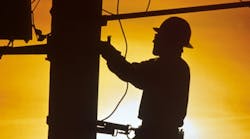Electrical workers are still in the top 10 most dangerous job list. But utilities are aggressively working to lower the number of accidents.
According to the Bureau of Labor Statistics, the number of job fatalities in the U.S. has been declining since 1994. 2014 was an aberration with a 2% increase over 2013 and a total of 4,679 fatal work injuries. Electrical powerline installers and repairers once again made the list of the top 10 most dangerous jobs. However, at 19.2 fatalities per 100,000 workers, the electrical worker fatal injury rate is the second lowest on this infamous list. That would seem to be somewhat good news. Falls, slips and trips; exposure to hazardous substances or environments; and transportation related incidents increased for the overall fatality data. Further, based on civilian job classification, construction and transportation/materials moving jobs have the highest fatality rate. These types of work activities are not foreign to the power industry. Somewhat surprisingly, the fatal work injury rate increases with age, potentially indicating seasoned workers become less careful.
Inherent Dangers
U.S. employers are quite dedicated to improving work conditions and job safety. That has always been the case in the utility industry based on my experience. However, there are inherent dangers in the workplace, particularly when construction, heavy machinery, transportation or bad weather are involved, all of which may be the case in instances such as storm restoration. Paul Mauldin did a story on electric job safety some years back. He correctly pointed out that fatalities are terrible whenever they occur on the job, but utility workers are definitely unsung heroes because they put their lives on the line every day and rarely get much recognition for it.
Every utility company as far as I am aware targets a zero fatality rate and most have goals regarding recordable injury rates. Thankfully, the rate of nonfatal workplace injuries and illnesses has been declining for over 10 years and now stands at 3.2 recordable incidents per 100 equivalent full time employees for all job categories. That means there were still nearly 3 million cases reported in 2014. The incidence rate for utilities as a category is actually lower at 2.4 than the overall job category rate. This may be the case in part because of the aggressive programs and policies utilities are putting in place to stress workplace safety.
Tools for Safety
Tools available to the power industry to rank safety performance include safety ratings complied by the Edison Electric Institute through an annual voluntary survey and the National Safety Council Barometer Survey that ranks employee feedback at all levels regarding a series of safety related questions. Many utility companies set goals to achieve a top decile safety performance rating compared to their peers or a 90% or higher rating in the barometer survey from employees regarding their company’s commitment and follow-through on safety issues.
Walter Brown, General Manager, Power Delivery with NextEra Energy Resources, has an interesting prospective on safety leadership. He recently led a Burns & McDonnell webinar on the topic and shared how NextEra is working toward first decile safety performance. Walter argues that achieving a high level of safety performance is a multiple step process. As with all worthwhile endeavors, the company and workers need a vision of what success looks like and then must establish a plan for achieving it and benchmark progress. Walter believes the goal must be achievable and that leadership is the critical ingredient. The leader’s role is to know his/her coworkers well enough to understand how to get them engaged, so they identify with the cause and become advocates. NextEra uses everything from safety songs to work zone safety kits and protection and control task videos to drive home the safety message. The plan has worked and recordable incidents at the company are continuing to decline.
Whether one’s role is that of manager or first year lineman, it is each individual’s obligation to take personal responsibility for his own safety as well as that of coworkers and the public. Walter Brown suggests we must all be leaders in the arena of workplace safety and ask ourselves every day “…what will I do differently to improve safety.”


